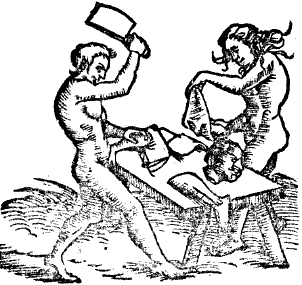Fury and Cannibalism July 5, 2011
Author: Beach Combing | in : Contemporary, Medieval, Modern , trackback
Cannibalism for most of us took place on ‘less happy (is)lands’ in less happy times, when neurologically-challenged Pacific folk loped from side to side suffering from Creutzfeldt–Jakob disease. Others might also recall occasional starving humans on boats, in plane wrecks or beseiged cities obliged to eat each other. But cannabilism does not, surely, figure in mainstream western history? Well, in fact, unlikely as this may seem, cannibalism was an occasional guest in renaissance and modern Europe particularly in cases where men-at-arms or rioting crowds lacked anger management training.
Take the death of Princess de Lamballe in 1792 at the hands of the sansculottes in the streets of Paris: the beautiful confidante of Marie Antoinette was butchered on the spot and allegedly her heart was taken and eaten by one rioter.
One of the brigands carried on the end of a pike that head from which hung a mass of blonde hair soaked with blood. He was followed by another, who carried in his hand the bloody heart of the princess while her entrails were twisted around his arm. In this way they passed under the windows of the Duc de Penago, whom they forced to gaze on the mutilated members of his daughter-in-law. From there they proceeded to the Temple, to the royal family. The queen fainted at the horrible sight. All the carriages in the streets were stopped and their occupants compelled to kiss the head of the princess. One monster boasted of having made his dinner on the heart of Madame de Lamballe.
In the wreckage and degradation of the Terror it is difficult to know whether to believe the cannibal details or not. However, a richer seam of cannibal claims appears in the fifteenth-century Italy and here there is no reason to doubt the excellent sources in which they appear.
In the Pazzi Conspiracy (1478 Florence), for example, the enemies of the Medici were hurled down from the high windows of Palazzo Vecchio and butchered in the Piazza della Signoria. Machiavelli describes the city square and the nearby streets littered with body parts. But this was not all. Florentine guards were said to have grabbed the dead or dying bodies hurled from the high windows and to have eaten their enemies’ livers raw! Similar stories can be found concerning the plot against Count Riario and concerning the assassination of the Duke of Milan (1476).
If we avoid a couple of German serial killers, twentieth-century examples are more difficult to come by. Beachcombing does though have some records from the Balkans where the special intensity of inter-ethnic conflict led to nibbling at human remains. There is one Yugoslav story that Beachcombing has come across on a number of occasions where a father is tricked by members of the enemy community into eating his own children. Folklore or, God forbid, folk practice?
Then, of course, there are the allegations of cannibalism practised by the Japanese army in the Second World War. A number of these can be explained by desperation and lack of supplies. But there were instances where Allied airmen, particularly, of course, bomber crews, were killed and partially eaten as an act of ‘total war’. The most notorious example of this took place in the ‘Ogasawara Incident’ in 1944/1945 (in reality a number of incidents) where US flight crews were executed and eaten. The following account from Time is not perhaps entirely neutral: no one though, including the condemnded, denied that parts of American airmen were devoured.
All these examples have in common cases of extreme hatred where killing is not enough. It is necessary also to obliterate and absorb your enemy. Beachcombing is looking for other Western or modern examples of anger cannibalism: drbeachcombing AT yahoo DOT com
***
5 July 2011: Java Man writes in with the story that George Bush senior was almost eaten by senior Japanese officers – ‘a hinge moment?’, writes Java Man: ‘The former President George Bush narrowly escaped being beheaded and eaten by Japanese soldiers when he was shot down over the Pacific in the Second World War, a shocking new history published in America has revealed. The book, Flyboys, is the result of historical detective work by James Bradley, whose father was among the marines later photographed raising the flag over the island of Iwo Jima. Lt George Bush, then a 20-year-old pilot, was among nine airmen who escaped from their planes after being shot down during bombing raids on Chichi Jima, a tiny island 700 miles south of Tokyo, in September 1944 – and was the only one to evade capture by the Japanese. The horrific fate of the other eight ‘flyboys’ was established in subsequent war crimes trials on the island of Guam, but details were sealed in top secret files in Washington to spare their families distress. Mr Bradley has established that they were tortured, beaten and then executed, either by beheading with swords or by multiple stab-wounds from bayonets and sharpened bamboo stakes. Four were then butchered by the island garrison’s surgeons and their livers and meat from their thighs eaten by senior Japanese officers.’ Thanks JM!!
12 July: Tokyobling also has cannibal memories: When thinking about the disgustig topic of cannibalism in modern times, one remembers the photos and reports of the Finno-Soviet war 1940-1945 that were declassified a couple of years ago to much disgust. Reports of field kitchens where Soviet soldiers cooked their fallen comrades, etc, half eaten limbs among starving encircled Soviet bivouacs. This should be readily googleable (spelling?). One also remembers the tales of cannibalism during the Cultural Revolution in China, where bullying and collective cannibalism merged in a disgusting soup. There should be plenty of stuff out there to google, especially the story of the girl who ate parts of her stepfather in order to show her defiance to his capitalist ways. Thanks Tokyobling!


